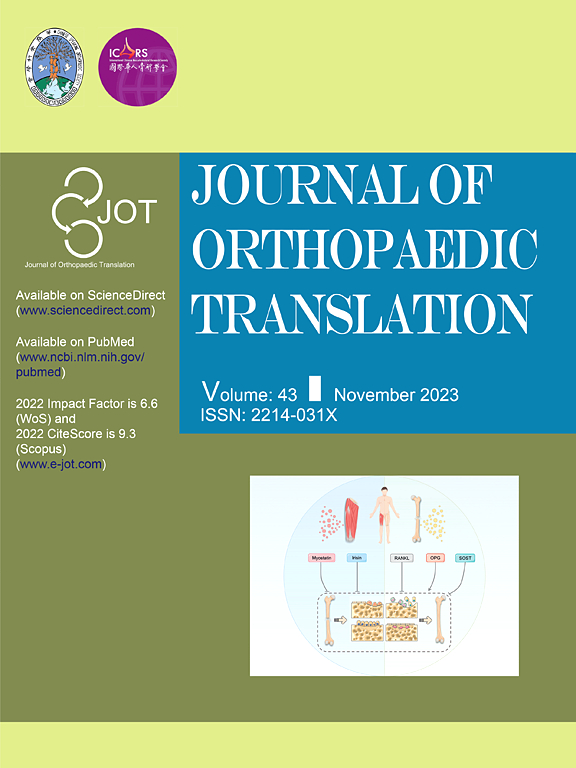Single-cell transcriptomic analysis reveals AP-1 downregulation remodels bone marrow environment and contributes to osteopenia in ovariectomized mice
IF 5.9
1区 医学
Q1 ORTHOPEDICS
引用次数: 0
Abstract
Background
Estrogen deficiency-induced osteoporosis largely results from disrupted immune environment in bone marrow, yet the underlying cellular and molecular mechanisms remain incompletely understood. This study aimed to investigate how estrogen deficiency alters bone marrow cellular composition and signaling pathways, with a focus on the regulatory role of activator protein 1 (AP-1) and its impact on osteoclastogenesis.
Methods
Single-cell RNA sequencing (scRNA-seq) was performed on bone marrow cells from sham-operated and ovariectomized (OVX) mice to map cell-type-specific changes. AP-1 inhibitor T5224 was administered to validate its functional role in vivo, while in vitro experiments assessed AP-1 activation via estrogen receptor signaling under estrogen stimulation. B lymphogenesis was pharmacologically inhibited using an IL-7 monoclonal antibody in OVX mice to evaluate its therapeutic potential.
Results
OVX mice exhibited a marked expansion of proliferative B cells (enriched in protein translation/DNA replication pathways) and reduced neutrophil proportions. scRNA-seq revealed widespread downregulation of AP-1 subunits, namely Fos, Fosb, Jun, Junb, across multiple cell types. T5224-induced AP-1 inhibition recapitulated OVX-associated B cell/neutrophil imbalance and triggered significant bone loss. Mechanistically, estrogen receptor activation upregulated AP-1 under estrogen stimulation, whereas AP-1 inhibition promoted B cell proliferation and increased GM-CSF and RANKL levels, thereby facilitating osteoclastogenesis. Critically, IL-7 antibody-mediated suppression of B lymphogenesis in OVX mice substantially attenuated bone loss.
Conclusion
AP-1 downregulation drives estrogen deficiency-related osteopenia by disrupting bone marrow homeostasis, primarily through excessive B cell expansion and elevated osteoclastogenic signaling. Targeting B cell proliferation via IL-7 blockade presents a potential therapeutic strategy for mitigating osteoporosis in estrogen-deficient conditions.

单细胞转录组学分析显示AP-1下调重塑骨髓环境并导致去卵巢小鼠骨质减少
骨髓免疫环境的破坏是导致骨质疏松的主要原因,但其潜在的细胞和分子机制尚不完全清楚。本研究旨在探讨雌激素缺乏如何改变骨髓细胞组成和信号通路,重点关注激活蛋白1 (activator protein 1, AP-1)的调节作用及其对破骨细胞发生的影响。方法对假手术和去卵巢小鼠(OVX)骨髓细胞进行单细胞RNA测序(scRNA-seq),绘制细胞类型特异性变化图谱。在体内给药AP-1抑制剂T5224验证其功能作用,体外实验评估在雌激素刺激下通过雌激素受体信号通路激活AP-1。用IL-7单克隆抗体对OVX小鼠的B淋巴生成进行药理学抑制,以评价其治疗潜力。结果sovx小鼠增殖性B细胞(富含蛋白质翻译/DNA复制途径)显著扩增,中性粒细胞比例显著降低。scRNA-seq显示AP-1亚基Fos、Fosb、Jun、Junb在多种细胞类型中普遍下调。t5224诱导的AP-1抑制重现了ovx相关的B细胞/中性粒细胞失衡,并引发了显著的骨质流失。机制上,雌激素受体激活在雌激素刺激下上调AP-1,而AP-1抑制促进B细胞增殖,增加GM-CSF和RANKL水平,从而促进破骨细胞的发生。关键的是,IL-7抗体介导的OVX小鼠B淋巴生成的抑制大大减轻了骨质流失。结论ap -1下调通过破坏骨髓稳态,主要通过B细胞过度扩增和破骨细胞信号的升高导致雌激素缺乏相关的骨质减少。通过IL-7阻断靶向B细胞增殖为缓解雌激素缺乏条件下骨质疏松症提供了一种潜在的治疗策略。
本文章由计算机程序翻译,如有差异,请以英文原文为准。
求助全文
约1分钟内获得全文
求助全文
来源期刊

Journal of Orthopaedic Translation
Medicine-Orthopedics and Sports Medicine
CiteScore
11.80
自引率
13.60%
发文量
91
审稿时长
29 days
期刊介绍:
The Journal of Orthopaedic Translation (JOT) is the official peer-reviewed, open access journal of the Chinese Speaking Orthopaedic Society (CSOS) and the International Chinese Musculoskeletal Research Society (ICMRS). It is published quarterly, in January, April, July and October, by Elsevier.
 求助内容:
求助内容: 应助结果提醒方式:
应助结果提醒方式:


